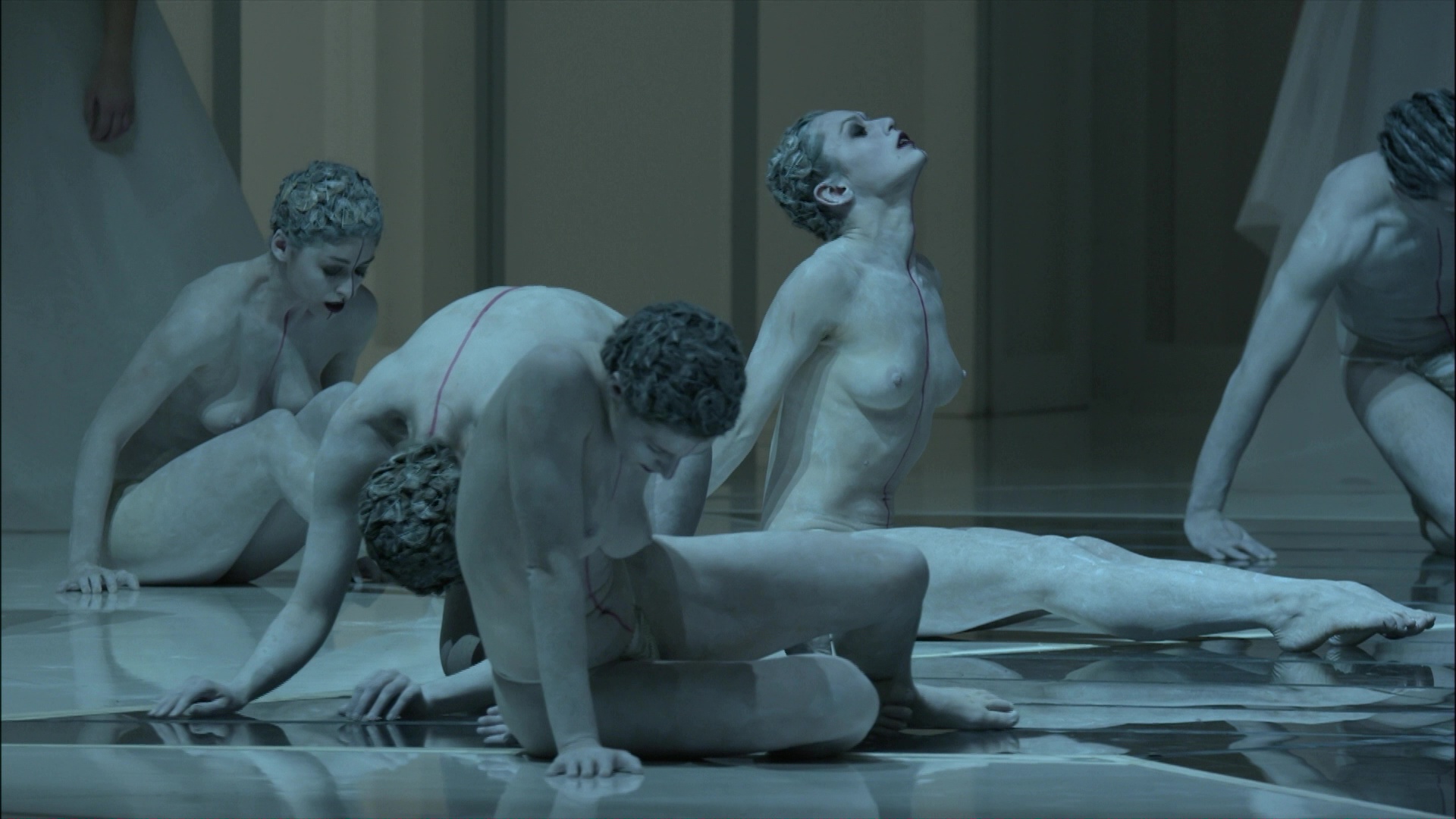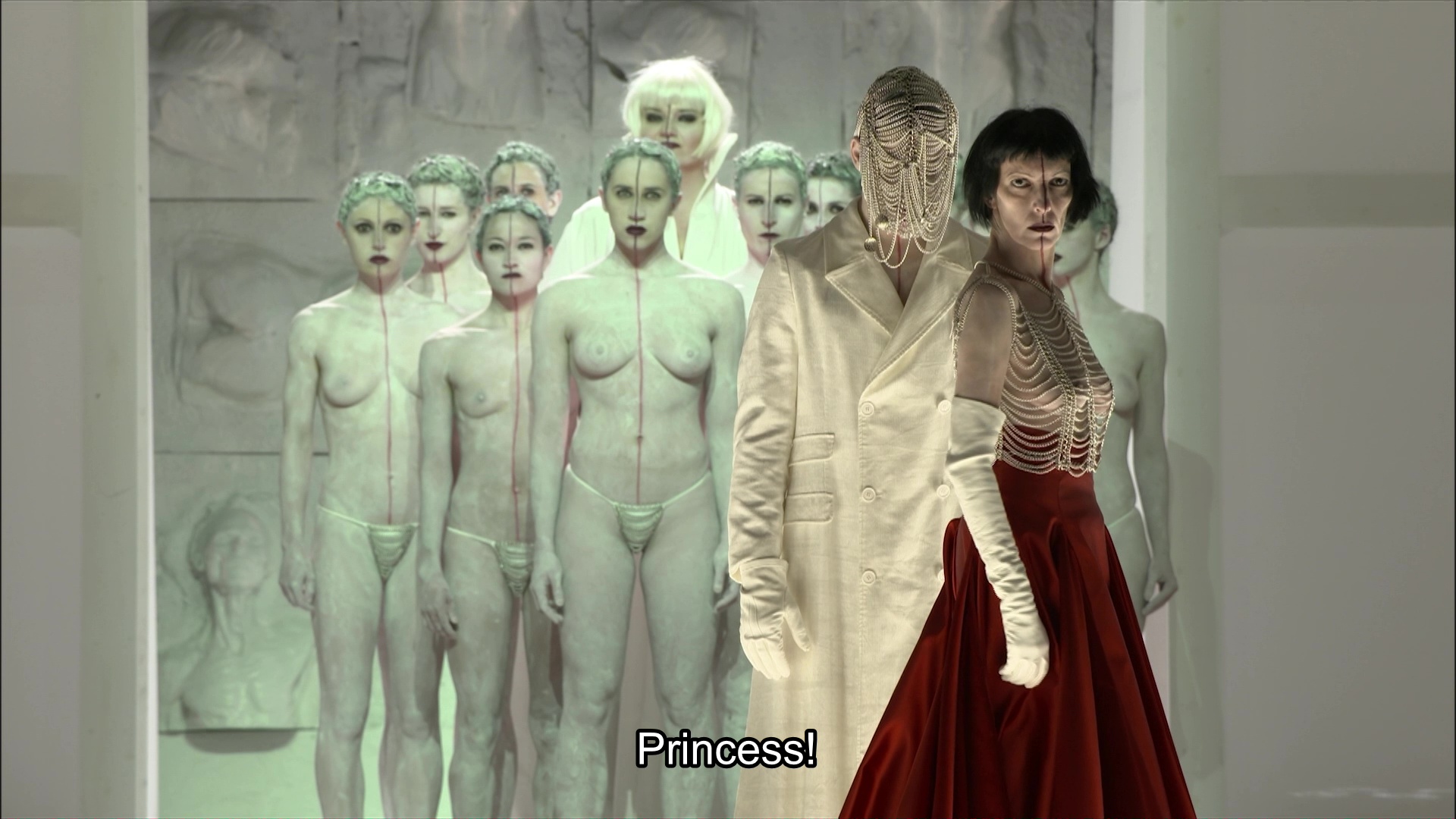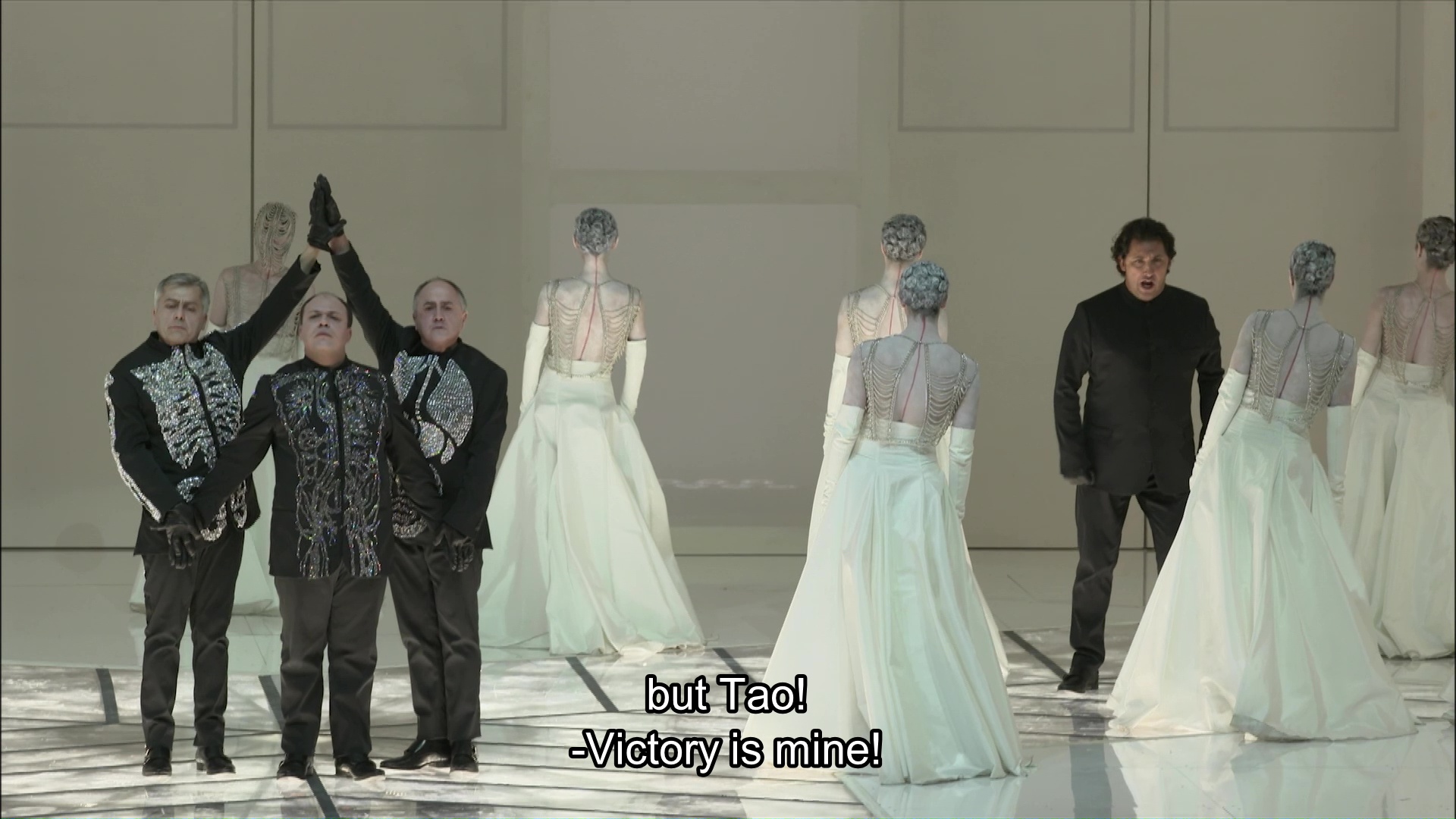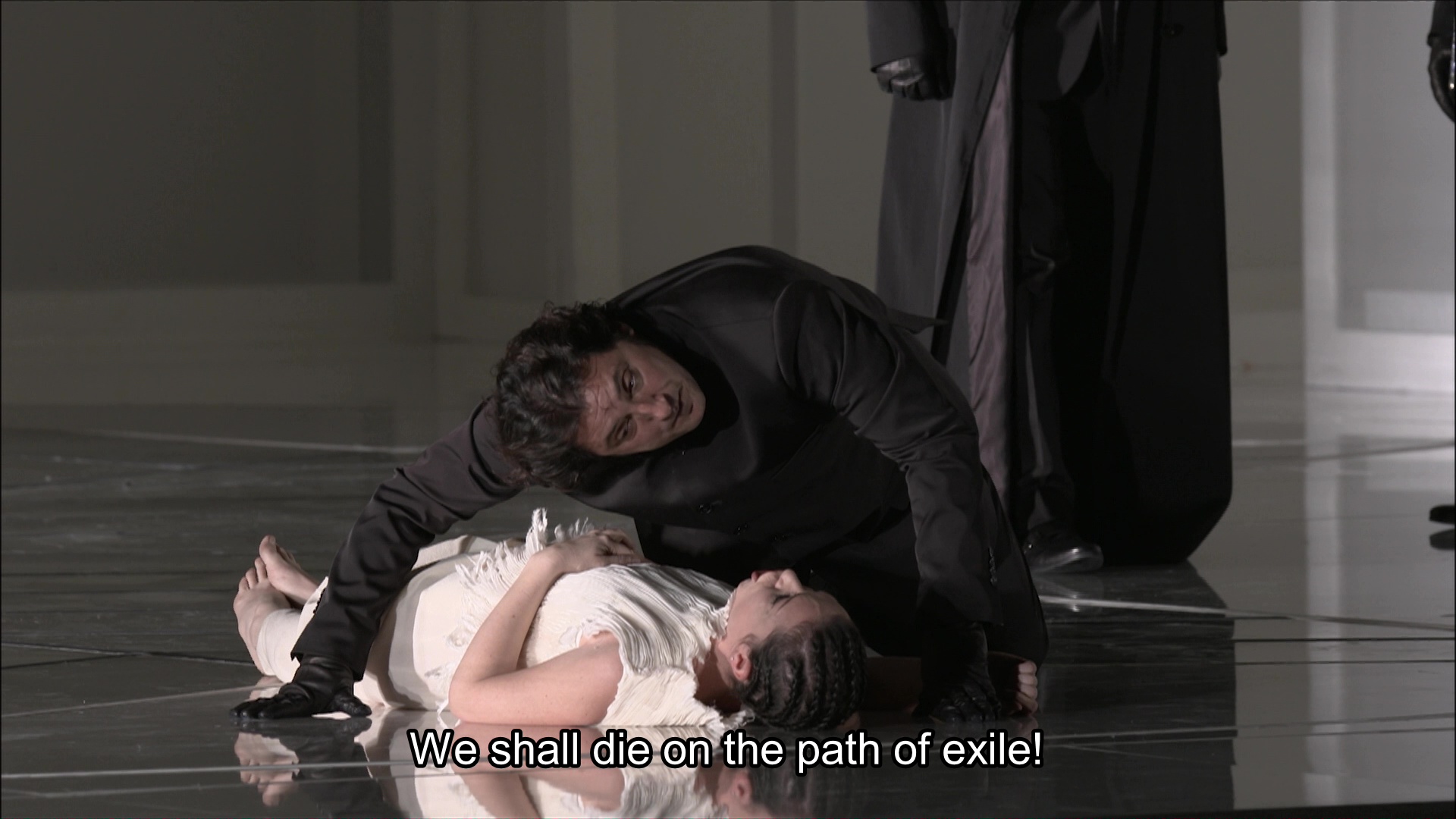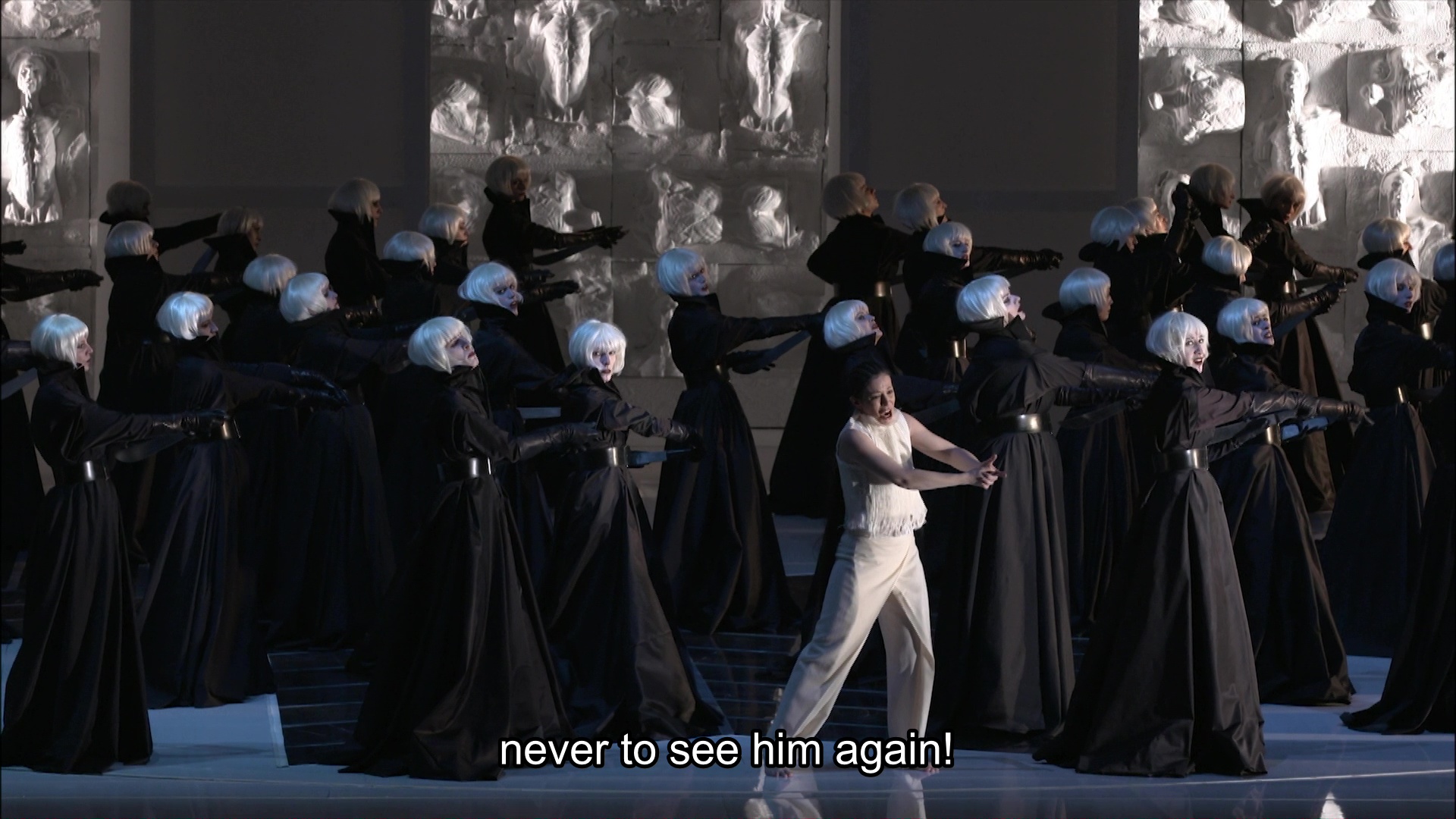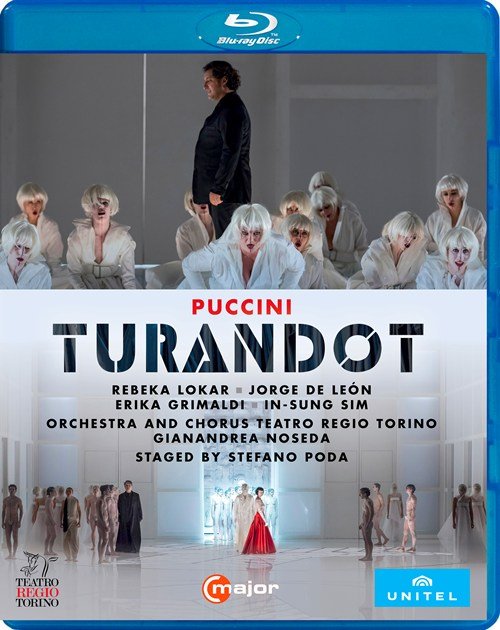
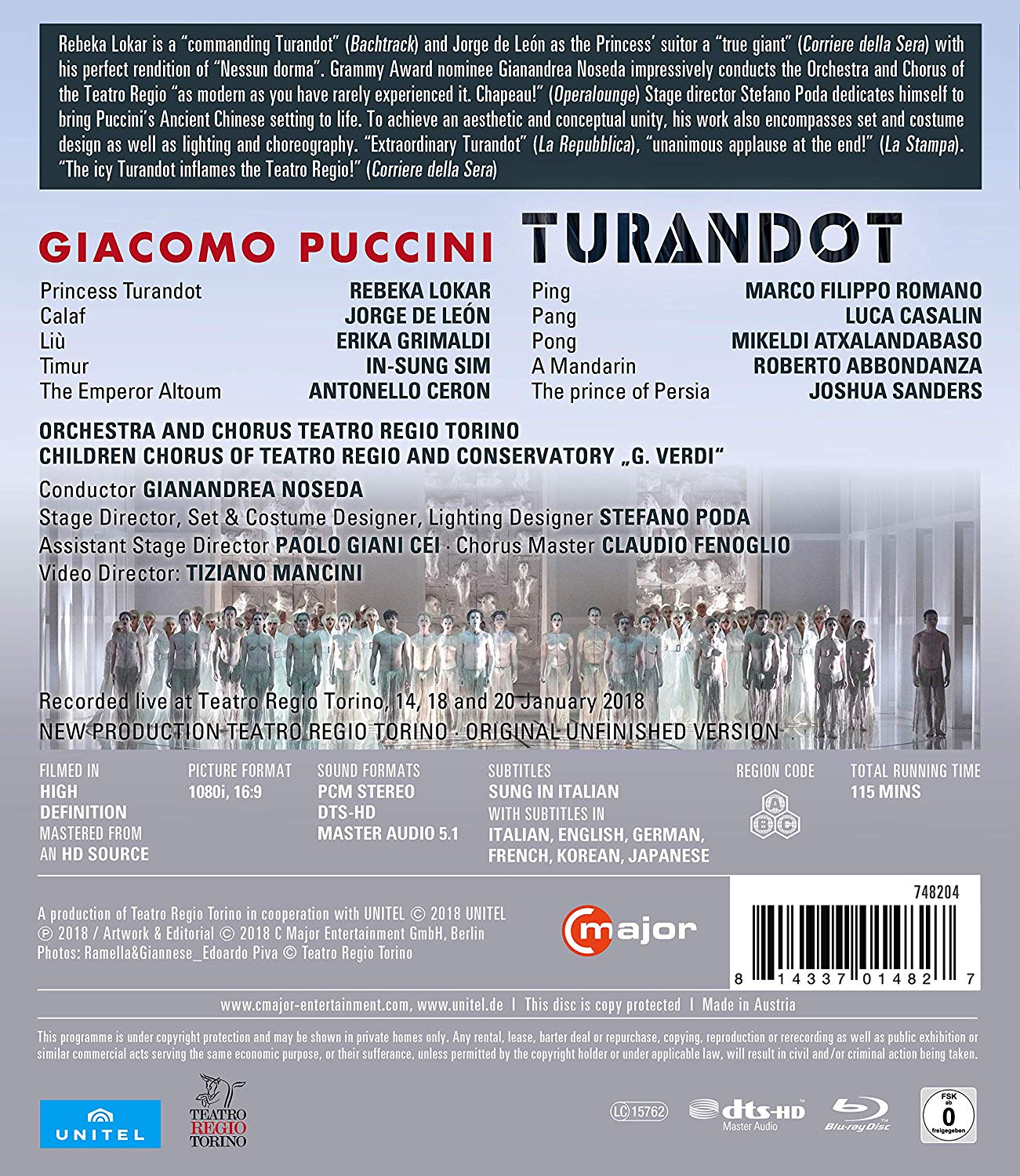
Puccini Turandot opera to a libretto by Giuseppe Adami and Renato Simoni. Directed 2018 by Stefano Poda at the Teatro Regio Torino. Stars Rebeka Lokar (Turandot), Jorge de León (Calaf), Erika Grimaldi (Liù), In-Sung Sim (Timur), Antonello Ceron (The Emperor Altoum), Marco Filippo Romano (Ping, Lord Chancellor), Luca Casalin (Pang, Majordomo), Mikeldi Atxalandabaso (Pong, Head Chef of the Imperial Kitchen), Roberto Abbondanza (A Mandarin), Joshua Sanders (The Prince of Persia [silent role]), Sabrina Amè (First Handmaid), Manuela Giacomini (Second Handmaid), and Nicoletta Cabassi (Pu-Tin-Pao, the Executioner[silent role]). Gianandrea Noseda conducts the Orchestra and Chorus of the Teatro Regio Torino (Chorus Master Claudio Fenoglio). Set design, costume design, lighting design, and choreography by Stefano Poda; collaborator director and assistant was Paolo Giani Cei. Directed for TV by Tiziano Mancini; Audio Producer Claudio Speranzini; Recording Engineer Antonio Martino; Audio Recording, Editing, and Mix by MASClassica. Sung in Italian. Released 2018, disc has 5.1 dts-HD Master Audio surround sound. Grade: A+
Stefano Poda, one of the most distinctive opera directors, has been involved in some 100 productions including at least 15 in his “unity style” in which he designs and directs everything that happens on the stage. His unity productions typically involve monumental (often multi-level) surreal modern sets that occupy the entire stage area and are decorated with elaborate designs, giant unique stage props, and grand coordinated color schemes (often white, black, and red) that undergird the sets and extend to his unique costumes—all supported by unusual dramatic lighting. The designs usually incorporate modern themes blended with classical motifs. He tends to put massive choral forces on the stage in identical costumes. Finally, he adds specially trained dance forces that often appear as close to naked as possible. Poda directs the movements of the dancers in manner that most choreographers would probable call pageantry or gymnastics.
All the elements of Poda’s unity style are present standing at attention in this challenging Turandot. In our first screenshot below meet Timur (In-Sung Sim) a deposed king traveling in exile with his faithful slave Liù (Erika Grimaldi). They just happen to find themselves in the crowd before the gate of the Forbidden City in Peking. You can tell they aren’t Chinese because they don’t have a red stripe running down the centers of their bodies:
Next below is Turandot (Rebeka Lokar). She’s got the red stripe. At any time, there seem to be only a few women around who can sing to role of Turandot; Lokar also appears in the 2018 Puccini Festival (Busch) we recently reviewed. The Chinese emperor wants her to marry and produce an heir; but she has a bias against men. So she puts herself up for auction to any prince who can solve 3 puzzles. So far this year 13 princes have tried and failed—and then been decapitated:
Next below we see Poda’s monumental modern set, the people of China in white, and the executioner’s assistants in various stages of undress:
The assistants have been tormenting Turandot’s latest victim, the Prince of Persia, since he flunked his test. The blue light means that the full moon has arrived, which is the signal for them to finish the Persian off:
Next below find, front to back, Pu-Tin-Pao, the Executioner (Nicoletta Cabassi), The Prince of Persia slathered in pearls (Joshua Sanders), the assistants, and Turandot supervising the action:
Also in Peking we meet Timur’s son Calaf (Jorge de León), seen on your right. On the left are Ping, Pang, and Pong, the Emperor’s kitchen cabinet. Although both Calif and Timur are in exile, Calaf is still a prince, and he really, really, really would like to become the son of the Chinese Emperor:
Timur and Liù beg Calif to forget the ice princess and leave Peking with them, but Calif insists that he must challenge Turandot:
This is worse even than the California Bar Exam with Turandot personally announcing the puzzles:
Calif aces the game when he gives “Turandot” as the correct answer for the third puzzle:
Next we see the Nessun dorma! scene with Calif wandering around (left rear) looking for Turandot. In case you are wondering why all the women in the chorus are dressed as the Princess, it has to do with Poda’s concept that Turnadot doesn’t actually exist but is only an hallucination. We usually think of Puccini as the grandmaster of 19th century grand romantic opera. But Turandot is actually an modern, 20th century work that premiered in 1926. But Nessun dorma! did turn out to be the end of the Age of Aria in opera. There have been many operas written since 1926, but nobody has been able since to come up with the kind of beautiful, romantic, tear-jerking music that made opera so powerful for centuries.
Poda stops where Puccini died, with the suicide of Liù. This may make for a jarring end to those used to the “happy ending” provided after Puccini death by Franco Alfano. But this is the only possible way for Poda to end his symbolic approach. We suspect Poda wanted to change the name of his production from “Turandot” to “Liù”, but he couldn’t convince the marketing people to go along with this. And we wonder what really killed Puccini in 1924. Was it oral cancer (too many cigars), or was the root cause years of indecision over what kind of opera he was writing? He should have consulted Shakespeare, who would have provided as the finale a battle between Calif and the executioner leaving all of the main protagonists dead on the palace floor:
Just for fun, we add 3 images from Poda’s website that show us the whole stage as someone in the theater would see it from a rear orchestra seat—videographer Tiziano Mancini’s video file has no images quite this long-range:
So what should we make of Poda’s treatment of Turandot? Per a discussion in the keepcase booklet, “Poda’s staging skillfully captures the subject matter conveyed: the brutality of a ruler who is nothing but a murderer.” We think Poda’s treatment is a bit more ambitious than that as he moves in the direction of making Turandot into a tragedy for all involved. We wonder if we will ever be able to enjoy again any traditional staging of this.
Neil Fisher, writing in the December 2018 Gramophone (pages 119-120) carps that ”The show forges its own hallucinatory logic . . . but as with so many productions where body-beautiful dancers dominate in revealing costumes under elaborate lighting, it feels as if the singers themselves are inconvenient bit-parts.” There is value in Fisher’s comment. For sure it’s hard at times to discern what you are hearing of Lokar’s voice as the chorus sings along with her in unison. And we wonder whether Poda’s approach is caused, at least in part, by the fact that the smaller opera venues where he typically works may often be unable to recruit the very best singers (especially after spending so much money on Poda’s unique sets, props, and costumes). But the singers hired for this show are all competitive, we think, with the best.
We heap special praise on the playing and recording of the orchestra under Noseda. We kept hearing details in the music that we couldn’t remember hearing before. We just did a special hearing comparison (in pure audio mode) of subject title and 5 other Turandot Blu-rays that resulted in the following conclusion: we can’t think of a better opera sound track on a Blu-ray video than this. Finally, the video in 2K Blu-ray is also excellent. (If only they had done this in 4K with HDR, which could have propelled this disc into the tiny group of the best fine-art videos ever!)
Now to a grade. If you are a traditionalist, the Met Blu-ray of the Zeffirelli production is still your anchor and there are other grade A titles to consider. Poda’s style here may be too harsh for younger viewers. For all others we feel Poda’s approach and the outstanding recording of the music make this the preferred recording with a grade of A+.
Here is an official trailer from the Teatro Regio Torino. It gives you good information as to what the disc is like even if it wasn’t taken from Tiziano Mancini’s video file shown on the C Major disc.
OR




